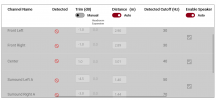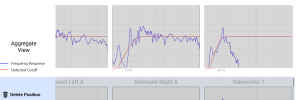Hello everyone,
Hope you are doing alright.
I need your expert opinion please.
My Setup:
Avr: denon 3700h
F: KEF R3
C: KEF R6
S: KEF Q150
SW: Rel 1003 HT MKii, connects to AVR SW out only via LFE channel.
Initial Settings
Mode: LFE@120Hz
XO: 100Hz for all speakers
Speakers: "Small"
SW XO knob: turn to max (200Hz)
SW Gain knob: 40%
AVR Sub level: -7 (lowest it can go is -12)
The story
I noticed my sub was rolling off quite a bit below 40Hz (see photo-1, L+R) no matter the position, so I contacted REL who suggested that I use their approach and set speakers to LARGE, LFE+Main, XO on avr to 250Hz and set the actual XO on the sub.
At which point I told them that this is against all the advise I have been given by all other enthusiasts in various forums and blogs but they insisted I give it a try.
So long story short, without changing the position of the sub I changed the settings as follows:
New Settings
Mode: LFE+Main@120Hz
XO: 200Hz
Speakers: "LARGE" for all speakers
SW XO knob: 100 Hz
SW Gain knob: 70%
Attached you can see the comparison (photo-2), blue line is the new settings REL suggested.
Questions
Many thanks to all have a Happy New Year!
Hope you are doing alright.
I need your expert opinion please.
My Setup:
Avr: denon 3700h
F: KEF R3
C: KEF R6
S: KEF Q150
SW: Rel 1003 HT MKii, connects to AVR SW out only via LFE channel.
Initial Settings
Mode: LFE@120Hz
XO: 100Hz for all speakers
Speakers: "Small"
SW XO knob: turn to max (200Hz)
SW Gain knob: 40%
AVR Sub level: -7 (lowest it can go is -12)
The story
I noticed my sub was rolling off quite a bit below 40Hz (see photo-1, L+R) no matter the position, so I contacted REL who suggested that I use their approach and set speakers to LARGE, LFE+Main, XO on avr to 250Hz and set the actual XO on the sub.
At which point I told them that this is against all the advise I have been given by all other enthusiasts in various forums and blogs but they insisted I give it a try.
So long story short, without changing the position of the sub I changed the settings as follows:
New Settings
Mode: LFE+Main@120Hz
XO: 200Hz
Speakers: "LARGE" for all speakers
SW XO knob: 100 Hz
SW Gain knob: 70%
Attached you can see the comparison (photo-2), blue line is the new settings REL suggested.
Questions
- There seems to be an improvement especially below 40Hz, would you recommend keeping the new settings?
- How do you interpret the results? Did I got lucky ?
- Does the FR draw the full picture or do I need to look at other metrics as well?
Many thanks to all have a Happy New Year!







